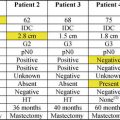Fig. 32.1
The top tasks, knowledge areas, and skills as rated by respondents (Reprinted with permission from Brown et al. [21]. Copyright 2012 by Oncology Nursing Society)
A breast cancer patient navigator fulfills a critical role for many patients who are just learning that they have been diagnosed with breast cancer. It is not unusual for a patient, in retrospect, to say that she felt like her navigator was her “lifeline,” her “go-to person,” “her support,” or “the one with the answers.” By navigating a patient, what is usually meant is that someone helps the patient move smoothly through the system, insuring that certain levels and expectations of their care are achieved in an efficient and effective manner [19]. The role of breast nurse navigator is considered crucial at our institution and has been fully supported for over 13 years.
Korber and colleagues [22] completed a study in 2011 examining the effectiveness of navigator programs. They utilized focus groups and a telephone interview with breast cancer patients, finding that all patients identified the critical role of navigators possessing information and education about the entire breast cancer process. We feel this is critical whether it is another specific type of cancer (thoracic, gastrointestinal) or any other cancer nurse navigation program.
This study further showed that the participants discussed the overwhelming nature of the treatment experience, which often made learning difficult. In their study, the navigator was seen as able to repeat, clarify, reinforce, and validate information the patient was receiving from multiple sources. Participants also noted the emotional support provided by the care team, particularly the nurse navigator, and significant others was key to their successful treatment completion.
Having this emotional support, the perception that “just being there” for them was seen as invaluable. In regard to teamwork, the importance of meeting the entire treatment team prior to starting therapy was identified. The multidisciplinary clinic approach was seen as helpful in clarifying roles, reinforcing support of caregivers, and instilling confidence that the collaborative team had a common understanding and acknowledgement of the plan of care. Formal introduction of team members, including a brochure describing each discipline and role, is extremely helpful. For the nurse navigator, a clear list of services, hours of availability, and contact numbers was extremely important to the patient and family members. The navigator was seen as playing a key role in obtaining and coordinating a vast array of medical and social services. Overall, Korber and colleagues felt that as breast navigator programs continue to grow, their impact and effectiveness on clinical outcomes must be examined [22].
One integrative review by Case in 2011 explored the presence of the oncology nurse as navigators on measurable patient outcomes. She identified 18 primary nursing research studies in her exploration, using a combination of keywords. These studies identify nursing-sensitive patient outcomes related to the time to diagnosis and appropriate treatment, effect on mood status, satisfaction, support, continuity of care, and cost outcomes. Of the study patient populations, patients with breast cancer were the predominant populations encountered. In her review, Case discusses how nursing researchers have clearly identified important outcomes that result from the presence of the oncology nurse navigator [23].
One of the studies Case cited was a study that we conducted in 2007, utilizing a telephone interview as part of a follow-up phone call. We identified the many needs and concerns of the newly diagnosed breast cancer patient. Emotional, social, and physical limitations were identified as most important in dealing with a breast cancer diagnosis. Our study indicated that fear of recurrence and anxiety regarding postoperative treatments accounted for more than 65 % of the responses to the question “What concerns you most about your new diagnosis?” These data reinforce the need for early postoperative follow-up and to provide printed materials that patients can use as a resource for their long-term information needs [24].
The provision of both educational materials and emotional support plays a major role at our institution. At the initial meeting among the patient, family members, and the breast nurse navigator, the navigator describes her role and ensures them that she will be with them throughout their cancer journey. The breast nurse navigator works with patients who have been diagnosed with breast cancer and provides up-to-date educational books and many resources to help them understand their diagnosis and treatment plan. The nurse navigator introduces the Multidisciplinary clinic approach for treatment and the importance of all the team members. The nurse navigator’s priority is to be accessible and present with the patient and family/caregivers and provide never-ending emotional support.
Navigation has a “ripple effect,” or as Webster Dictionary defines it, “a spreading, pervasive, and usually unintentional effect or influence.” As patient navigation evolves as a strategy to improve outcomes in cancer patients by removing barriers to diagnosis and treatment, the process and the navigators will have a ripple effect upon patient care. Healthcare systems often bring fragmented pieces of care, whether in physical layout, internal design, political cultures, or other complexities. Gentry reported that the goal of patient navigation is not to compete among healthcare systems but to meet the needs of the patient with personal and accessible healthcare services. Thus, the PN can be the consistent face and voice throughout the maze of appointments, procedures, tests, and treatments. As confidence is gained to access care and patients are empowered to move through the healthcare system, the effects are seen as positive [8, 9, 25].
McDonald and Abella [26] provide an excellent view of the importance of the role of the nurse navigator in their article entitled “The impact of nurse navigation on the patient experience.” They recognize and acknowledge that a diagnosis of cancer can be a life-changing event, with the journey from diagnosis to survivorship, and perhaps to end-of-life care, filled with fear, challenges, and uncertainties. They discuss the value of patient navigation provided by a highly experienced, knowledgeable, and compassionate oncology nurse. This may be described best by the patients who share their comments and stories with others members of the healthcare team. They felt fortunate to have been connected with a CNN as their journey began. By being connected to, and supported by, a CNN when newly diagnosed with cancer, this helped the patient and families develop a profound sense of security and safety.
It also helps to decrease fears and anxiety, thus allowing patients to effectively hear and process the tremendous amount of information that is often presented to them about their cancer treatment. Informed and personalized decision-making becomes a much more comfortable process as the CNN begins to outline what patients may experience as well as serve as their guide to support their unique journey. The authors state that having a CNN shepherding a patient’s care across the continuum using the clinical expertise embedded in an evidence-based nursing practice is paramount to assure excellence in service and to optimize a patient-centered experience.
Stay updated, free articles. Join our Telegram channel

Full access? Get Clinical Tree







